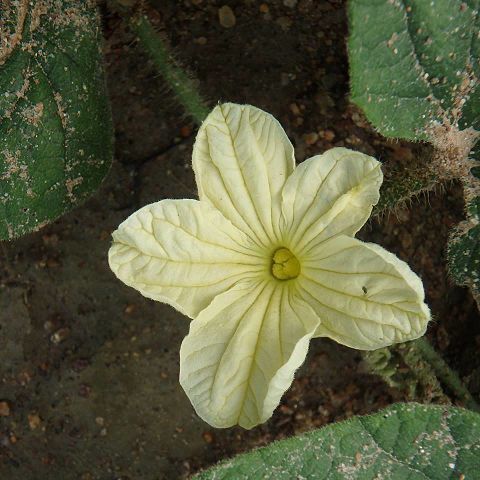Coarse trailing perennial herb to 2.5 m.; rootstock large, woody; stems shortly and finely to long and coarsely spreading-hairy, like the leaves often darkening when dried.. Leaf-blade ovate, ovate-triangular, elongated-ovate, elliptic or lanceolate in outline, unequally sinuate-toothed or sometimes serrate-lobulate, subtruncate or subcordate at the base, ± softly-to very scabrid-hairy, especially beneath, 12–143 mm. long, 10–95 mm. broad, unlobed or variously shortly 3(–5)-lobed, with the central lobe much the longest; petiole ± spreading-bristly, 3–55 mm. long.. Dioecious.. Male flowers in sessile or 1–47 mm. pedunculate groups of 2–14, usually with a coaxillary solitary flower, occasionally solitary; pedicels 4–60 mm. long; receptacle-tube 3.5–7 mm. long; lobes ± linear, 1.5–9 mm. long; petals pale yellow with green veins, 6–21 mm. long, 3.5–13 mm. broad, united at the base.. Female flowers 1–2(–3) on 11–23 mm. long stalks; ovary ellipsoid, 8–10 mm. long, 3–6 mm. across, densely hairy; receptacle-tube ± 4 mm. long and 3.5–4 mm. across; lobes subulate, 1.5–2 mm. long; petals 7–10 mm. long, 3.5–5 mm. broad, united at the base.. Fruit on a 20–39 mm. long stalk, subglobose, 40–47 mm. long, 37–42 mm. across, green with darker mottlings, irregularly primrose-yellow and finally brownish-orange when ripe, smooth.. Seeds (fig. 16/10, p. 101) ovate in outline, lenticular, 7 × 5 × 2 mm.
Dioecious, hairy, perennial herb, rootstock woody. Stems procumbent, up to 2 m long. Leaves up to 210 x 105 mm, outline ± ovate, entire or 3-5-palmately lobed, base subcordate to obtuse, apex acute to obtuse, margins serrate, lobes oblong to triangular, central lobe longest; petioles up to 55 mm long. Tendrils simple. Male flowers ± racemose, 2-11-flowered; peduncle up to 450 mm long; pedicels up to 85 mm long; receptacle campanulate, up to 9 mm long; lobes linear, up to 6 mm long; corolla campanulate, hairy outside, glabrous inside; tube 6-10 mm long; lobes ± triangular, up to 9 mm long. Female flowers 1-3, glabrous inside; pedicels up to 70 mm long; receptacle ovoid, up to 13.5 mm long; lobes ± triangular, up to 6 mm long; corolla tube up to 11 mm long; lobes ± elliptic, up to 14.5 mm long. Flowering time Nov.-Jan. Fruit ± globose, dark green lengthwise stripes first; pedicels up to 95 mm long. Seeds ovate, up to 80 mm long.
Leaf-lamina 2–15 × 1–10 cm., broadly ovate or ovate-triangular to narrowly ovate, elliptic or oblong-lanceolate in outline, hastate, weakly cordate, truncate or rounded at the base, obscurely and minutely sinuate-denticulate to coarsely sinuate-serrate, usually rather densely hispid or setulose becoming scabrid-punctate above, densely finely setulose to scabrid-setulose or scabrid-punctate beneath, obtuse to acute, apiculate, unlobed or variously palmately 3–5-lobed, lobes ovate-triangular to linear, the central much the largest.
A herb. A pumpkin family plant that keeps growing from year to year. It has a tuberous root. The stems and stiff and angular. The leaves vary in shape. They can be 8-12 cm long. The male and female flowers occur separately. The male flowers are long and 2.5 cm across. They occur as 1-3 together. The female flowers occur singly. The fruit is oval and 3 cm across. It has a few hairs. The fruit are mottled green and white. The seeds are small.
Prostrate or scandent perennial herb, dioecious (male and female flowers on different plants). Tendrils solitary at each node. Fruit without apically setiferous spines or tubercules, smooth. Seeds ovate in outline, 6.5-9.0 x 4.9-6.3 x 2.1-3.2 mm. Flowers white, cream, pale yellow or yellow.
male flowers solitary or 2–12 in lax or contracted sessile or pedunculate fascicles; peduncle 2–80 mm. long; pedicels 3–73 mm. long. Receptacle-tube 2·7–9 mm. long; lobes 1–9 mm. long. Petals 3·5–22 mm. long, white, cream, pale yellow or yellow.
Female flowers solitary or paired; pedicel 7–26 mm. long; ovary 9–13 × 4–12 mm., ellipsoid or ovoid-ellipsoid, densely appressed-or patent-setulose; perianth similar to that of male flower, the petals rather larger, 13–31 mm. long.
Fruit 2·5–7 × 1·5–6 cm., globose to oblong-ellipsoid, rounded at the ends, smooth, longitudinally striped light and dark green becoming concolorous yellow and finally brownish-orange when ripe; fruit-stalk 1·8–6·2 cm. long.
Perennial; rootstock fibrous, woody; stems prostrate or scandent, to 2·5 m., sparsely to densely patent-setulose, becoming thickened and woody at the base.
Seeds 6·5–9 × 4·9–6·3 × 2·1–3·2 mm., ovate in outline, smooth, compressed, not bordered, white.
Petiole 0·5–5·5 cm. long, more or less patent-setulose or hispid.
Flowers dioecious.

